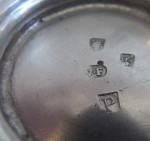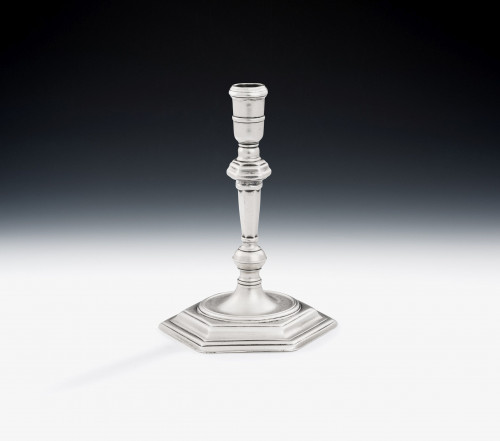- Home
- British Silver 1649-1759
- A very fine & unusual early George II Sugar Bowl, with pull off cover which doubles as a spoon tray. Made in London in 1730 by William Fordham.
A very fine & unusual early George II Sugar Bowl, with pull off cover which doubles as a spoon tray. Made in London in 1730 by William Fordham.
A very fine & unusual early George II Sugar Bowl, with pull off cover which doubles as a spoon tray. Made in London in 1730 by William Fordham.
374604
The Bowl stands on a spreading circular foot which is decorated with reeded bands. The main body is beautifully baluster shaped and is plain in design with a slightly everted rim. The stepped pull off cover is decorated with reeding and also has an unusual rim applied to the cover, which when the tray is in use, doubles as the foot of the tray. The front of the main body is beautifully engraved with a contemporary Armorial surrounded by a pluming scroll and strap work cartouche, which is typical of the 1720/30's. The engraving has been very finely executed. The bowl and cover are very well made and display fine original centre points on both sections, where it was measured from. These are always nice original features to see, which show quality of design and production. The Bowl is in excellent condition, has an excellent colour and is fully marked in the foot and with the maker's mark and sterling mark on the interior of the cover.
This piece would have been a most important part of the Tea Equipage upstairs in the drawing room. Tea was an important social tradition at this date, as tea was so very expensive and confirmed social position and status. This example is most uusual, in that the cover can be turned upside down and used as a rest for spoons, mote spoons or possibly the sugar nips.
Our heraldic advisor has looked into the Armorial and concludes that they are those of the very ancient Shropshire family of Acton. They are specifically those of Sir Richard Acton, 5th Baronet. He was born in 1711/12, the only son and heir to Sir Whitmore Acton, 4th Baronet, who died in 1731. Sir Richard married in 1744, Lady Anne Grey, daughter of the Earl of Stanford. William Fordham made fine sugar bowls and cream jugs for the tea table. He was apprentice to Melior Benskin, entering his first mark in January, 1707. He had workshops in Lombard Street, when this piece was made.
Height: 3.6 inches, 9cm.
Diameter at the rim: 4 inches, 10cm.
Weight: 7oz.
Thank you for your enquiry.
We will get back to you soon.
Please create wishlist to add this item to
RELATED ITEMS

























